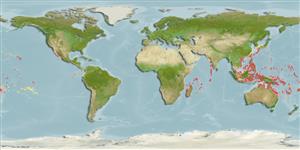>
Gobiiformes (Gobies) >
Gobiidae (Gobies) > Gobiinae
Etymology: Eviota: No etymology given, suggested by Christopher Scharpt: from Latin 'eu' for 'true' and 'iota' for anything very small, in combination 'truly very small' referring to it as being the smallest vertebrate at the time it has benn described by Jenkins (thus, making the suggestion by Scharpt plausible.
More on author: Smith.
Environment: milieu / climate zone / depth range / distribution range
Sinh thái học
Biển Cùng sống ở rạn san hô; Mức độ sâu 0 - 18 m (Ref. 86942). Tropical
Indo-Pacific: from the East African coast (Mozambique) and Seychelles, Aldabra, and Chagos; the East Indian region; southward to Australia; north to Japan and Micronesia (Palau, Guam, Northern Mariana Islands, Federated States of Micronesia, Marshall Islands, and Kiribati [Line Islands]), and east to French Polynesia (Society Islands).
Bộ gần gũi / Khối lượng (Trọng lượng) / Age
Maturity: Lm ? range ? - ? cm
Max length : 1.9 cm SL con đực/không giới tính; (Ref. 1602)
Các tia vây lưng cứng (tổng cộng) : 7; Các vây lưng mềm (tổng cộng) : 8; Tia cứng vây hậu môn: 1; Tia mềm vây hậu môn: 8 - 9. Characterized by semi-transparent, greenish-brown body with about six faint, internal dark bars; scale margins narrow orange-brown; short brown bars across top of head and along upper back; presence of dark internal blotches above anal fin and lower edge of caudal peduncle; upper portion of caudal peduncle with large black spot; eleventh to fifteenth pectoral rays usually branched; ctenoid scales, absent on head, nape and pectoral fin base; longitudinal scale series 23-24; separated pelvic fins, thin membrane joining bases; rudimentary fifth pelvic ray; average of 6-7 branches on fourth pelvic ray; depth of body 3.6-4.2 in SL (Ref. 90102). Dorsal to anal fin-ray formula 8/8.
Inhabits shallow coral reefs to about 10 m (Ref 90102).
Life cycle and mating behavior
Chín muồi sinh dục | Sự tái sinh sản | Đẻ trứng | Các trứng | Sự sinh sản | Ấu trùng
Myers, R.F., 1991. Micronesian reef fishes. Second Ed. Coral Graphics, Barrigada, Guam. 298 p. (Ref. 1602)
IUCN Red List Status (Ref. 130435: Version 2024-2)
Threat to humans
Harmless
Human uses
Các công cụ
Special reports
Download XML
Các nguồn internet
Estimates based on models
Preferred temperature (Ref.
123201): 24.7 - 29.3, mean 28.2 °C (based on 2315 cells).
Phylogenetic diversity index (Ref.
82804): PD
50 = 0.5000 [Uniqueness, from 0.5 = low to 2.0 = high].
Bayesian length-weight: a=0.00692 (0.00284 - 0.01683), b=3.10 (2.92 - 3.28), in cm total length, based on LWR estimates for this Genus-body shape (Ref.
93245).
Mức dinh dưỡng (Ref.
69278): 3.0 ±0.3 se; based on size and trophs of closest relatives
Thích nghi nhanh (Ref.
120179): Chiêù cao, thời gian nhân đôi của chủng quần tối thiểu là dưới 15 tháng (Preliminary K or Fecundity.).
Fishing Vulnerability (Ref.
59153): Low vulnerability (10 of 100).
Nutrients (Ref.
124155): Calcium = 534 [216, 1,997] mg/100g; Iron = 1.97 [0.76, 4.78] mg/100g; Protein = 17.5 [15.3, 19.5] %; Omega3 = 0.102 [0.029, 0.360] g/100g; Selenium = 37.2 [8.8, 132.2] μg/100g; VitaminA = 101 [16, 587] μg/100g; Zinc = 5.63 [2.78, 10.07] mg/100g (wet weight);
